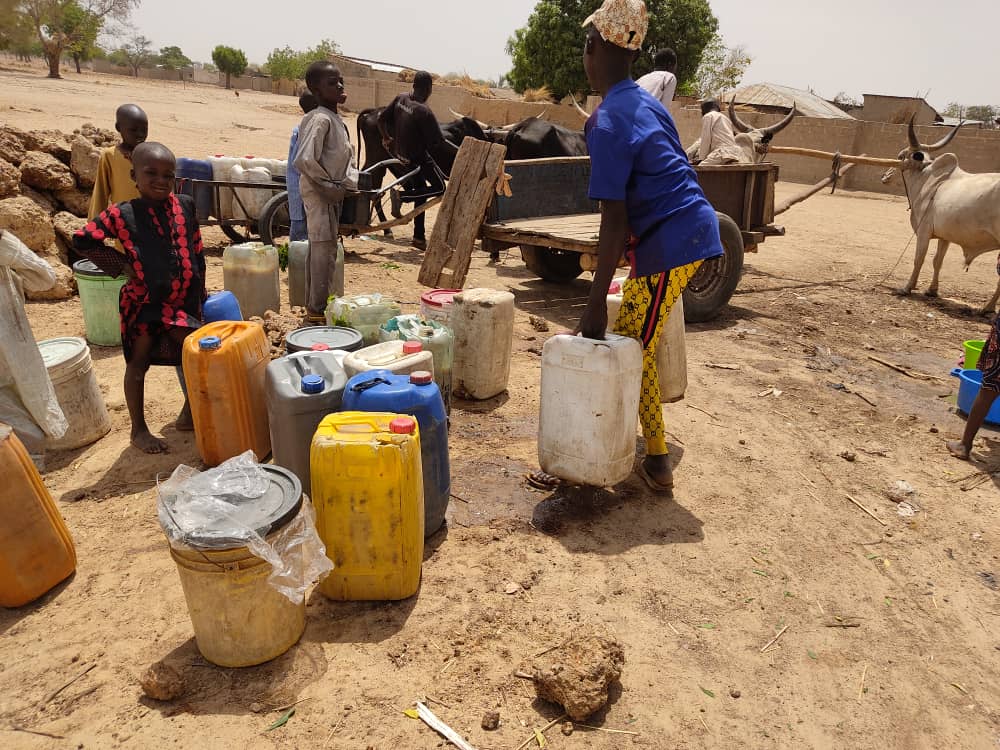By Ibrahim Babangida Lawal
Yar-Mamman, Kano State
At dawn, before the golden sun stretches over the Sahelian plains of northern Nigeria, a quiet desperation takes root in Yar-Mamman. Women clutching plastic containers and jerry cans begin their solemn procession to the village’s only water well — a lifeline fast becoming a symbol of despair.
Yar-Mamman is a remote village located in Tsanyawa Local Government Area, some 70 kilometers north of Kano City,with a population of roughly 10,000. Yet, in this large and lively community, water — the most basic human necessity — is a rare and precious commodity.
The heart-wrenching reality is that one well, overburdened and dangerously shallow, is all that stands between survival and catastrophe.
“We sometimes wait two days just to fetch a bucket of water,” murmured Amina, a mother of four, her sun-wrinkled face revealing years of quiet endurance. “The well is not enough for all of us — humans and animals alike.”
The communal well, shared by villagers and livestock, has become a breeding ground not just for tension and frustration, but for disease. According to health volunteers in the area, the contamination of the water has led to outbreaks of waterborne illnesses such as diarrhea, typhoid, and skin infections, with children bearing the brunt of this public health crisis.
Yar-Mamman is surrounded by other rural communities — Dutsen-Kafa, Korwa, Daddarawa, Rinjim Kaftuda, and Zango — each facing similar or even worse water conditions. But Yar-Mamman has become emblematic of the silent suffering playing out in Nigeria’s rural hinterlands.
“The children are the most affected,” said Malam Sani, the local Islamic school teacher. “Many have stopped coming to class — not because they don’t want to learn, but because they have to help their mothers fetch water. Some trek long distances with heavy loads on their heads instead of carrying books to school.”
The ripple effects of this water crisis are vast. In addition to the health and educational setbacks, economic activity in the village has slowed. Women who once supplemented their household income through petty trading or farm work now spend hours at the well, competing in long queues under the punishing sun.
Village leaders have not been silent. The traditional head of Yar-Mamman recalls receiving visits from political figures like Senator Barau Jibrin Maliya and former local government chairman Alhaji Sani Bala. But their visits, though high in rhetoric and fanfare, have yielded little in terms of tangible solutions.
“They came with promises, but left us with our thirst,” the village head said in a tone heavy with resignation. “We are tired of waiting. Our people are dying slowly.”
The people of Yar-Mamman are not asking for luxury — they are pleading for clean, accessible water. Simple boreholes, a small treatment facility, or even rainwater harvesting systems could change the course of their lives. But those solutions remain distant dreams.
In the absence of government intervention, residents have turned to non-governmental organizations and the media, hoping their story might stir conscience and action.
“We don’t need pity, we need help,” said Hauwa, a youth advocate in the community. “This is 2025. No human being should be denied water.”
As Nigeria continues to boast of development milestones and smart city initiatives, villages like Yar-Mamman remain trapped in an old cycle of neglect. Their thirst is not just for water — it is for dignity, attention, and justice.
For the children of Yar-Mamman, every drop counts. For their mothers, every dawn is a test of endurance. And for the leaders who have the power to change this narrative, every day that passes without action is a silent betrayal.
Source: MATASHIYA TV
Contact for Further Information:
📞 08096399266
📞 07060859911
The North Journals | Deep stories, Real people, Real impact.
© 2025 All Rights Reserved.


